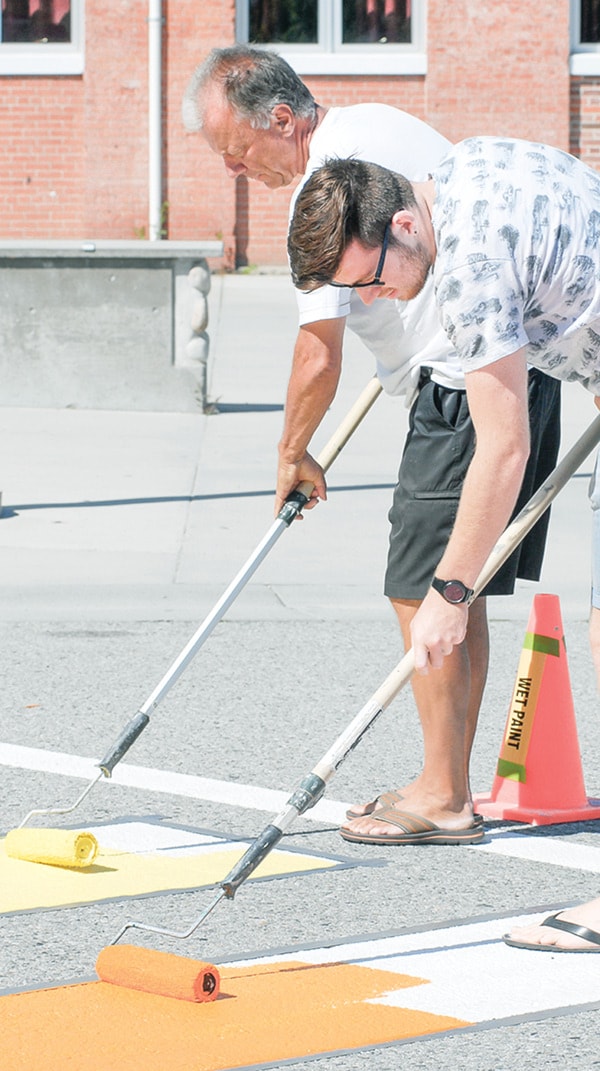A rainbow crosswalk isn’t likely to show up on Penticton streets anytime soon.
The idea of adding a rainbow crosswalk was first brought to council in August 2015 as other communities in the valley adopted them as a way of signifying they were welcoming, especially in terms of the LGBTQ community, where the movement originated. Since that time, a group of Penticton Secondary School students has moved ahead and painted the crosswalks on the school property in rainbow colours. (Read more on that HERE)
The city won’t be following suit. A report delivered by staff on inclusivity covered a wide range of options, but didn’t encourage a rainbow crosswalk as one of the steps.
“I believe those conversations started around a rainbow sidewalk, but I think we all agree that diversity and inclusion is more than just a sidewalk,” said Gillian Kenny, the city’s Manager of Human Resources, as she presented the report. Instead, they tried to look at the widest range possible, including differences in ethnicity, age, religion, philosophy, physical abilities, socioeconomic background, sexual orientation or gender identity, intelligence — all under the inclusive banner.
Kenny said there are a number of reasons Penticton needs to be a diverse and inclusive community.
“It is to grow our residence base, it is to create a sense of belonging so people want to stay in our community,” said Kenny. “We need to improve our own local economy. The city has a moral obligation to guard its citizens’ human rights.
“Ultimately we need to create a better place to live.”
Kenny said they did create a small committee to examine best practices and have been working with South Okanagan Immigration and Community Services, the Penticton museum, Pacific Sport, South Okanagan Gay and Lesbian Association and the Community Foundation South Okanagan.
“We are absolutely looking for more partnerships,” said Kenny. “We need to make change, not just talk about it. We need to partner for success, we need to earn a reputation as a community that respects and promotes human rights.”
Kenny’s report suggested a number of directions this work could take.
“We need to strengthen our city policies to counter all forms of discrimination to achieve greater social inclusion, which may include things such as an accessibility policy or even an updated OCP,” said Kenny. “We need to review our internal processes and train for diversity and bias recognition. And we need to communicate with our citizens to engage them in this process.”
The city’s recruitment process would be a good example where bias recognition training would come in, according to Kenny.
“Are we posting to appropriate locations where everybody can see the availability of that position?” she asked. “Are the visually impaired able to view our presentation today on the internet? We need to look at inherent biases and do some training amongst our staff to review those things.”
While a rainbow crosswalk is off the table, Kenny said the city is looking to recognize Okanagan Pride Week, Aug. 6 to 13. Jakubeit suggests the city could put banners up along designated streets to recognize different groups like the LGBTQ community, providing the groups would be willing to pay for them.
“We had a discussion at a community of the whole about recognition about banners or flags. We were talking a bit more about banners, because that is a little bit easier to maintain. If we are to recognize a group for a week, other than a proclamation, should we run a separate flag, which I think is a bit outdated, or should we put banners along the 100-block in front of City Hall that signify Pride Week or Rotary Week or Metis or whatever it is,” said Jakubeit, who suggested various groups could apply for Neighbourhood Small Grants from the CFSO to pay for them.
“There is still a cost to putting them up and producing banners. That might be an opportunity for groups to get some banners that are generic enough to be used for three years. Our donation might be putting them up along a certain set of blocks,” said Jakubeit.
Kenny noted that the city had participated in several inclusion-oriented events, including participating in the Welcoming Communities Summit. But more needs to be done, Kenny suggested.
“We need to complete those 2016 actions, we need to review our accessibility and potential improvements. We need to develop our public relations campaign, and we need to bring forward a 2017 budget request to support these diversity initiatives,” she said.
